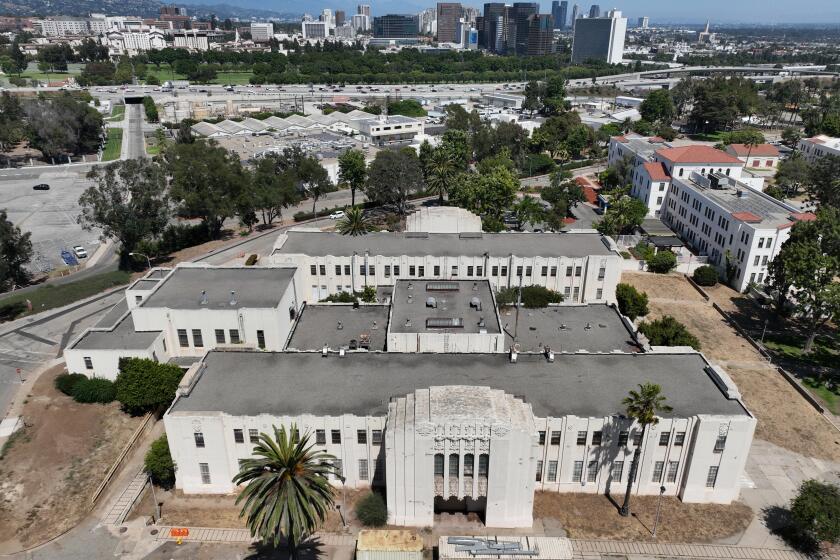Locke High’s weary teachers face a hard multiple-choice test
At a better school, in a less desperate part of the city, Zeus Cubias might have shrugged off the disruption.
But after a decade teaching at Locke High School -- one of the worst in the Los Angeles public school system -- he was annoyed when a recent geometry class ended with one more small reminder of how much things need to change.
Cubias had wolfed down his lunch and hustled back to his room for the start of class. He launched enthusiastically into a special two-day lesson he had devised.
“All right, your job is to paint the school,” he said, his voice raspy from a morning of classes. “How can we use geometry to figure it out?”
The hour passed quickly as talk turned to angles, protractors and calculating area. A minute before the bell was to sound, Cubias warned his students that they would need a quick start the next day in order to finish the assignment.
“Sorry, Cubias,” one student called out, “I won’t be here. Field trip to the beach.”
“Me too,” a chorus of others chimed in.
Standing at the front of the room, the teacher bowed his head and rubbed his eyes wearily -- the frustration welling up. Half his students would be absent the next day, and no administrator or other teacher had bothered to tell him. The lesson he had designed would have to be postponed.
“I’m just tired, man,” he said later. “Tired that whenever you want to do something positive for the kids, it’s a struggle. It shouldn’t be this hard.”
Cubias is symbolically at the center of a power struggle taking shape in the mammoth Los Angeles Unified School District, the nation’s second largest. With a prominent charter school organization challenging the district for control of Locke, the school’s teachers ultimately must decide which is better able to deliver badly needed reforms.
The direction that Cubias and the rest of the faculty choose could have far-reaching implications for L.A. Unified, as teachers at other schools consider similar options.
The charter group, Green Dot Public Schools, shocked district officials in May when it announced that a majority of Locke’s tenured teachers had signed petitions in support of a Green Dot takeover, clearing the major legal barrier to converting the campus into several independent schools.
District officials countered with promises to teachers of increased authority and reforms if Locke remained within the district. After several teachers rescinded their signatures, saying they were confused about the takeover proposal, district officials threw out the formal takeover plan submitted by Green Dot.
Recent days, however, have brought a shift in direction at the district headquarters as a new school board majority allied with Mayor Antonio Villaraigosa has taken control. On Tuesday, new board member Richard Vladovic, who represents the Locke area, presented a motion to require an up-or-down vote in August on the Green Dot petition.
The charter group’s leaders have vowed to press ahead, one way or another, with plans to convert Locke by 2008. Green Dot is planning to open two small charter schools near Locke this fall. To propel this effort, the Bill & Melinda Gates Foundation announced Monday that it had given Green Dot an $8-million grant to develop charter schools in the Locke-Watts area.
The battle over charter schools has roiled Locke. Some teachers angrily oppose a takeover, while others are eagerly supportive. Many remain undecided.
For Karen Brown, who has taught at Locke for 16 years and heads the school’s widely respected fashion design program, Green Dot is nothing more than an unproven, uninvited group attempting a hostile takeover.
She and other longtime Locke teachers are suspicious of Green Dot’s labor contract with its union, which does not include the detailed work rules, job protections or lifetime benefits granted district teachers. Moreover, those teachers reject the idea that Locke is broken.
“We are confident that we can continue to give our students what they need. We don’t need anybody from the outside coming in telling us how to do our job,” Brown said. Green Dot “cannot prove to me that they can do a better job. Not here.”
For Cubias, 32, a Locke graduate who grew up in the poor, violent neighborhoods surrounding the South L.A. campus, the field trip debacle reflected larger problems at a school he sees as struggling in an ineffective district. Much of the charter school’s model appeals to him.
Green Dot’s plan for Locke calls for the large campus to be divided into several small, autonomous schools with separate faculties and principals.
With a small central office and administrative staff for their schools, Green Dot officials say, they funnel more state funds into classrooms than the district does and give teachers and principals considerable control over budgets and instruction.
Cubias said he worries that the relatively small Green Dot operation could be overwhelmed by the numerous needs and demands of the school’s 2,800 students. And he wonders whether the benefit of starting over from scratch and leaving the school district would outweigh the huge disruption to students and teachers that such a drastic move would entail.
Although much of the debate about Locke’s future has played out in heated faculty and community meetings after hours, at times it has spilled into the school’s wide cinder-block corridors.
“Why are you even here? Why don’t you just leave?” gym teacher Simone Chait hollered at an English instructor, Bruce Smith, who has vocally supported Green Dot, one morning as dozens of students looked on.
“Because I want something better for these kids. I don’t want half of them to disappear,” he shot back, referring to the school’s 50% dropout rate.
The decision whether to leave the district would be much easier for Cubias if he hadn’t seen some progress in recent years.
Take the third-floor math lab that opened this year. A windowless room with missing ceiling panels and exposed pipes, it has new computer terminals running a specialized software program that provides instruction for struggling students at high risk of dropping out.
Teaching leaves him exhausted, but Cubias clearly enjoys the four remedial algebra classes he teaches each day in the lab. Students work on their own, each struggling in different areas and often calling out, “Cubias, some help!” or “Cubias, over here!” He moves from one to the next, leaning over their shoulders, helping them work through equations and graphs.
He understands them -- how they feel like they could drop out and no one at the school would notice or care -- because he used to be one of them. Once a failing student who frequently ditched classes in order to hang out at the school’s handball courts, Cubias credits a demanding English teacher with keeping him in school.
“People tell me my problem is that I take this too personally,” he said. “I have a really hard time explaining to them that I do take this personally because this is personal for me.”
Cubias also sees promise in the cadre of young, talented teachers who have been hired in recent years and now make up about half of Locke’s math faculty.
And then there are the signs, however fleeting, that the school can offer a student a way out. Walking down the hall, he points to a gangly, shaggy-haired kid loping down the hallway, the first anyone can remember being admitted to the Massachusetts Institute of Technology. And Cubias notes that the number of students going on to two- and four-year colleges has been climbing in recent years.
But he knows too well that progress is still the exception, instead of the rule, at Locke. And such signs of hope, he added, have come mostly despite L.A. Unified, not because of it.
“We can see some light,” Cubias said. “But between us and that light is a system that makes everything so difficult.”
Locke’s crew of young math teachers did not land at the school through the district’s recruiting and placement office, Cubias said, but because of an informal pipeline he forged with UCLA’s education program.
He and other teachers have taken it upon themselves to keep close tabs on new recruits -- stopping by their classrooms between periods or offering advice over a meal after work.
And, when it came to funding the computer lab, the faculty didn’t even bother to ask district administrators but secured money themselves directly from the state.
Moreover, in the decade since he earned his teaching credential and returned to Locke, Cubias recalls five principals arriving to run the school. More than a dozen assistant principals have come and gone as well, he said, typically using Locke as a stopover on the way to better positions elsewhere in the sprawling 708,000-student district.
“We get people coming here more to put in their time than to serve the kids,” he said. “They are not the type who want to rock the boat when they’re here.”
The revolving door for administrators, Cubias and several other teachers on both sides of the Green Dot divide said, has left teachers with the sense that the school is adrift, missing the consistent leadership that is often a key element of more successful schools. Without it, small frustrations like the field trip mishap are frequent, and larger reform efforts, including a sweeping plan to divide the campus into several semiautonomous learning communities, have faltered.
And it’s the kids, Cubias said, who have paid the price. For every student who graduates from Locke, there is still one who drops out. For years, the school has languished at the bottom of the state’s ranking system, and it fares only slightly better when compared to schools with similar challenges.
Last year, 72% of Locke’s juniors tested either “below basic” or “far below basic” on California’s standardized English test, and 89% of students who enrolled in algebra classes scored at those levels.
Whichever side prevails in the battle for Locke, teachers will continue to face the host of challenges that students bring to school.
This year more than 70 Locke students were either on probation or had been issued bench warrants for their arrest. The year before, nearly 175 students were suspended for violent incidents. Dozens of the teenagers live in foster care.
At the end of a recent class, a withdrawn pregnant teenager approached Cubias at his desk to timidly show him photos from her first sonogram. Minutes later, he broke up a gaggle of students gathered in the hallway around a classmate -- a single mother selling candy from a duffel bag.
“I tell teachers, if you’re going to come here, you’ve got to expect stuff like this,” he said, “It’s part of life here.”
--
--
(BEGIN TEXT OF INFOBOX)
Green Dot’s rules
Green Dot Public Schools operates 10 charter high schools in and around Los Angeles, serving about 3,000 students. The faculty and principals at each school are given broad discretion over budgets and instruction, but all Green Dot schools must adhere to a set of basic tenets. Charter schools are independently run and publicly financed. Some nonnegotiable rules at Green Dot campuses:
* No school can enroll more than 525 students.
* All students must complete the rigorous curriculum required for admission to the University of California.
* Parents or guardians must commit to at least 35 hours of service at their child’s school each year.
* Schools must remain open to students until at least 5 p.m. each school day.
Source: Times reporting
More to Read
Sign up for Essential California
The most important California stories and recommendations in your inbox every morning.
You may occasionally receive promotional content from the Los Angeles Times.











